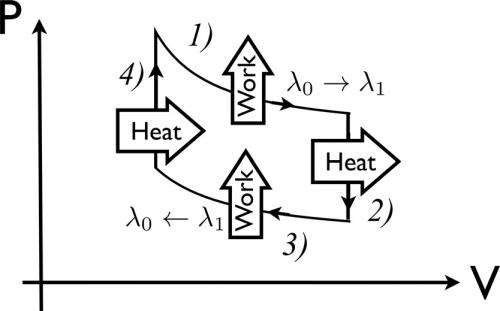September 16, 2014 feature
Physicists design zero-friction quantum engine
Lisa Zyga
contributing writer

(Phys.org) —In real physical processes, some energy is always lost any time work is produced. The lost energy almost always occurs due to friction, especially in processes that involve mechanical motion. But in a new study, physicists have designed an engine that operates with zero friction while still generating power by taking advantage of some quantum shortcuts.
The laws of thermodynamics successfully describe the concepts of work and heat in a wide variety of systems, ranging from refrigerators to black holes, as long as the systems are macroscopic. But for quantum technologies on the micro- and nano-scale, quantum fluctuations that are insignificant on large scales start to become prominent. As previous research as shown, the large quantum effects call for a complete reformulation of the thermodynamics laws.
What a quantum version of thermodynamics might look like is not yet known, and neither are the limitations or possible advantages of the quantum devices that would be described by such laws. However, one intriguing question is whether it may be possible to build a reversible quantum engine—one in which the engine's operation can be reversed without energy dissipation (an "adiabatic" process).
In the new paper, the physicists have shown one example of a quantum engine that is "super-adiabatic." That is, the engine uses quantum shortcuts to achieve a state that is usually achieved only by slow adiabatic processes. This engine can achieve a state that is fully frictionless; in other words, the engine reaches its maximum efficiency, while still generating some power.
"Shortcuts allow us to 'mimic' what would be achieved by running a cycle quasi-statically, i.e., very slowly, while performing transformations at finite time," coauthor Mauro Paternostro at Queen's University in Belfast, UK, told Phys.org. "Now, consider for instance a compression or expansion stage of a cycle run using a piston. When doing it at finite time, i.e., non-zero velocity, friction might affect the performance of the transformation. Yet, by using a shortcut to adiabaticity, friction-like effects would get quenched, the cycle performance being the same as that of a quasistatic motor."
The work marks a step toward the key engineering goal in this context, which is to find the maximum efficiency allowed at the maximum possible power. As the scientists note, this pursuit is complicated by the existence of a trade-off between the running time of the super-adiabatic process and the corresponding amount of work dissipated.
"This work is one of the first steps into the merging of quantum control and thermodynamics," Paternostro said. "We have shown that it is possible to use techniques that, to date, have only been used for other goals (population transfer, for instance) for thermodynamic tasks and the engineering of efficient cycles."
Overall, the results suggest the possibility of a frictionless quantum engine operating at maximum efficiency, which has implications in designing micro- and nano-scale motors operating at the verge of the quantum scale. In the meantime, there are still several hurdles to overcome.
"I think that the real challenge is the use of such techniques in interacting quantum many body systems, whose inherent complexity and rich phenomenology could be 'tamed' by the use of this sort of quantum control," Paternostro said. "At the end of the day, thermodynamics is a theory of many particles, and its quantum formulation should be able to cope with many-body effects, whose control could hugely benefit from the implementation of schemes similar to the one proposed in our paper. We have new and exciting results, in this context, that will come up soon and that will hopefully have an impact in the community interested in many-body physics and quantum thermodynamics."
Written for you by our author Lisa Zyga—this article is the result of careful human work. We rely on readers like you to keep independent science journalism alive. If this reporting matters to you, please consider a donation (especially monthly). You'll get an ad-free account as a thank-you.
More information: A. del Campo, et al. "More bang for your buck: Super-adiabatic quantum engines." Scientific Reports. DOI: 10.1038/srep06208
Journal information: Scientific Reports
© 2014 Phys.org


















